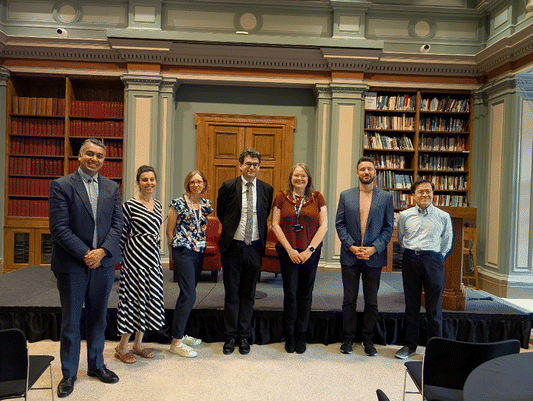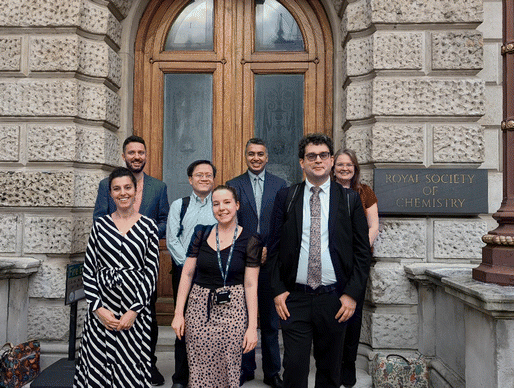 Open Access Article
Open Access ArticleCreative Commons Attribution 3.0 Unported Licence
Reflecting on another successful year of Energy Advances
Volker
Presser

INM – Leibniz Institute for New Materials, 66123 Saarbrücken, Germany. E-mail: volker.presser@leibniz-inm.de
In 2024, we were delighted to hold the Energy Advances Editorial Board meeting in person at our London office, Burlington House. The day was filled with exciting discussions about the success and future of the journal. We were also fortunate to have Editorial Board members Matthew Suss, Raymond Wong and Michael Naguib attending in person.
Celebrating excellence in research
The scientific contributions published in Energy Advances this past year exemplify the breadth and depth of innovation in energy research. Among the most-read articles of 2024 were several outstanding studies showcasing both the diversity of topics and the quality of work in the journal.Acid–base concentration swing for direct air capture of carbon dioxide (Anatoly Rinberg and Michael J. Aziz) https://doi.org/10.1039/D4YA00251B
This groundbreaking study introduces a novel acid–base concentration swing process for capturing carbon dioxide directly from the atmosphere. By leveraging pH changes in aqueous solutions, this technique allows for efficient CO2 absorption and release, presenting a promising pathway toward climate change combatting technologies. The research not only demonstrates theoretical efficiency but also validates the approach experimentally, marking a significant advance in direct air capture technology.
Recent advancements in catalyst coated membranes for water electrolysis: a critical review (Rajangam Vinodh, Tamilazhagan Palanivel, Shankara Sharanappa Kalanur, and Bruno G. Pollet) https://doi.org/10.1039/D4YA00143E
This comprehensive review highlights innovations in catalyst-coated membrane (CCM) technology, a critical component of water electrolysis systems for green hydrogen production. It examines the latest developments in materials design, fabrication techniques, and durability enhancement strategies, providing a roadmap for future advancements in sustainable hydrogen production.
Rechargeable iron-ion (Fe-ion) batteries: recent progress, challenges, and perspectives (Jitendra Kumar Yadav, Bharti Rani, Priyanka Saini, and Ambesh Dixit) https://doi.org/10.1039/D4YA00101J
Iron-ion batteries are emerging as an eco-friendly and cost-effective alternative to lithium-ion systems. This review details advancements in electrode and electrolyte development, analyzes electrochemical performance, and addresses challenges in scalability. The authors provide a compelling case for further exploration of iron-ion batteries as a sustainable energy storage solution.
Quantitative local state of charge mapping by operando electrochemical fluorescence microscopy in porous electrodes (Anton M. Graf, Thomas Cochard, Kiana Amini, Michael S. Emanuel, Shmuel M. Rubinstein, and Michael J. Aziz) https://doi.org/10.1039/D4YA00362D
This paper introduces a cutting-edge technique for visualizing the state of charge in porous electrodes using operando electrochemical fluorescence microscopy. The method enables real-time monitoring of charge distribution with unprecedented spatial resolution, offering valuable insights into battery performance and optimization.
Comparative evaluation of the power-to-methanol process configurations and assessment of process flexibility (Siphesihle Mbatha, Xiaoti Cui, Payam G. Panah, Sébastien Thomas, Ksenia Parkhomenko, Anne-Cécile Roger, Benoit Louis, Ray Everson, Paulo Debiagi, Nicholas Musyoka, and Henrietta Langmi) https://doi.org/10.1039/D4YA00433G
This study evaluates various configurations for power-to-methanol production, focusing on scalability and energy efficiency. By identifying optimal setups for methanol synthesis, this research underscores the potential of this approach in integrating renewable energy with green chemical manufacturing.
A cradle-to-gate life cycle assessment of green methanol production using direct air capture (Nicholas Badger, Rahim Boylu, Valentine Ilojianya, Mustafa Erguvan, and Shahriar Amini) https://doi.org/10.1039/D4YA00316K
This work presents a detailed life cycle assessment of green methanol production via direct air capture (DAC) and renewable energy. The authors analyze environmental impacts across various energy configurations, offering a holistic view of the potential for achieving carbon-neutral methanol production.
These, and so many more of our journal's articles, reflect our commitment to fostering cutting-edge science that addresses urgent environmental and societal challenges.
Expanding engagement through conferences and collections
Energy Advances has also been active in the global scientific community, supporting key conferences like the Munich Hydrogen Symposium, the Asia-Pacific Solar Research Conference, and the MRS Spring Meeting. These events provided vital platforms for collaboration and knowledge exchange, further amplifying the journal’s impact.Themed collections published this year, including Blue and Green Hydrogen Production & Storage and Flowable Energy Storage, underscored the importance of integrative approaches to energy research. These curated collections continue to guide researchers toward innovative and sustainable solutions for energy challenges.
Milestones and the path ahead
One of the year’s most notable achievements was the announcement of Energy Advances first Impact Factor of 3.2. This milestone reflects the hard work of our authors, reviewers, and editorial team and highlights the journal’s growing role in the energy research community. In alignment with the Royal Society of Chemistry’s broader transition to open access publishing, Energy Advances is proud to be a gold open access journal, ensuring that research is widely available and easily accessible. In July 2024, Energy Advances introduced article processing charges (APCs) for articles that are accepted following peer review. The competitive APC is in place to support a sustainable open access business model. The Royal Society of Chemistry is a not-for-profit publisher, so our APCs not only cover the high-quality peer review process for the journal and the maintenance of our publication platforms, but also support the services and resources the Royal Society of Chemistry provides to the community. The Royal Society of Chemistry is working to develop more institutional agreements to cover APC costs rather than individual payments, aiming to minimize the financial barriers for authors.We are also delighted to announce a significant step for Energy Advances towards fostering greater transparency and openness in our publishing process by introducing transparent peer review (TPR). This initiative is aligned with the Royal Society of Chemistry’s commitment to open science and will provide our readers with deeper insights into our published research and peer review processes. As a result of introducing TPR, when an author now submits their manuscript to the journal, they have the option of choosing whether the peer review reports, author responses and decision letters are published alongside their paper and made publicly available. Our authors can change their mind about choosing TPR at any point during the peer review process. Our reviewers will now be informed at invitation stage that their reports may be made publicly available. The reviewers’ anonymity will be maintained, unless they choose to sign their report. Further information about TPR can be found at https://www.rsc.org/journals-books-databases/author-and-reviewer-hub/process-and-policies/#peerreview.
As we move into 2025, Energy Advances remains dedicated to championing high-quality, impactful research. Whether through innovative studies, thematic collections, or active conference participation, we aim to advance the dialogue and solutions for a sustainable energy future.
To our authors, reviewers, and readers, thank you for making 2024 a remarkable year. Together, let us continue to build on this momentum and inspire the next wave of discoveries in energy science.
| This journal is © The Royal Society of Chemistry 2025 |


